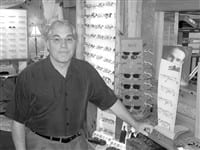Eyes Stand Corrected Experts Say The Future Of Vision Care Offers Several Options For Better Sight
Watch any episode of Star Trek and three things are immediately noticeable: In the future, there are no doorknobs, denim jeans, or eyeglasses. As to which will go away first, with today’s emphasis on vision correction, it looks like we’ll still be turning a knob to open a door, but we won’t need glasses to find it.
From bifocals to contact lenses to LASIK surgery, there are many options for people with imperfect vision.
Demon Eyes?
While most of the effort in vision correction is focused on permanent fixes like LASIK or lens-replacement surgery, there is still work being done to improve the contact lens experiences for specific segments of users. One high-profile project is a joint venture between Nike and Baush & Lomb called MaxSight.
MaxSight contact lenses are kind of like wearing sunglasses directly on the eyes. A recent article in The Sporting News highlighted the contact lenses and the success some professional baseball players are having as a result of using the contacts.
The contact lenses for baseball players are bright amber and block out blue light, giving other colors more clarity, such as the red seams on a baseball. By seeing the rotation of the seams as the ball approaches, a seasoned hitter can tell what kind of pitch it is, such as fastball, curve ball, or slider. As an added bonus, the tint gives batters a ghoulish look, which may creep out a pitcher or two.
There also is a gray-green lens for stationary sports, such as golf. The lenses help golfers differentiate shades of green on a golf course. According to The Sporting News, golfer Justin Leonard told Nike he could separate every blade of grass on the course.
While the contact lenses are still in the testing phase, glasses with the lenses are available now. The contact lenses will be available through vision care centers in the near future.
Permanent Solutions
While the tinted contact lenses can temporarily improve vision, permanent vision correction solutions also are available. For the past 10 years or so, millions of people around the world have had their vision permanently corrected through LASIK surgery. LASIK stands for Laser-Assisted In Situ Keratomileusis. It’s a procedure that permanently changes the shape of the cornea resulting in greater focusing power. The surgery, while proven to be safe, is still rather costly and isn’t always covered by insurance.
If using lasers to improve vision seems like something out of science fiction, then wait for what’s coming next: Intraocular lens replacement.
Alcon, one of the leader’s in eye care products, recently announced that the Food and Drug Administration approved its AcrySof® ReSTOR® intraocular lens (IOL) for cataract patients with and without presbyopia. This new lens uses apodized diffractive technology to give patients a full range of quality vision (near, intermediate, and distance) that greatly increases their independence from glasses after surgery. The clinical studies supporting the approval showed that 80{06cf2b9696b159f874511d23dbc893eb1ac83014175ed30550cfff22781411e5} of patients who received the AcrySof® ReSTOR® lens did not use glasses for any activities after surgery.
The first IOL replacement in the greater Springfield area took place at the end of June and was performed by Dr. John Papale, a Springfield-based ophthalmologist.
“Lens replacements for cataract patients have been around since the 1940s,” said Papale. “The breakthrough with this lens replacement is that it improves far and near vision. It allows for good focus and is good for distance and reading without glasses. It’s better than LASIK.”
The Future of Eyewear
With the advances in permanent vision correction, a Star Trek future of no eyewear seems inevitable. Not so fast, says Papale.
“Glasses will always be here,” he said. “Cost will be a barrier to some people. And fear will be a barrier, too. As it is, only about 5{06cf2b9696b159f874511d23dbc893eb1ac83014175ed30550cfff22781411e5} of people who could get LASIK surgery actually get the surgery.”
This is good news for people like Ken Gaspar, one of the owners of Kens’ Eyewear. With four stores in Western Mass., the Kens’ Eyewear is the second largest independently-owned vision center chain in Massachusetts.
Kens’ still grinds its own lenses and can fill any prescription – something Gaspar claims the larger chains can’t or won’t always do. And with their ability to create specialty optics, they can meet the one need that isn’t going away any time soon – magnifying units for people suffering from macular degeneration.
As the general population continues to age and life expectancy continues to increase, macular degeneration will become more common. MD is the malfunction or loss of function of the most concentrated collection of sight-sensing cells in the macular region of the retina resulting in the loss of vital central or detail vision. According to Papale, MD is the result of two main factors: aging and heredity. As we age, the risk of MD increases. Since we’re living longer these days, the instances of MD are becoming more common, as people diagnosed with MD are usually over 55 years of age. The heredity/genetic factor is usually tied to those of Northern European descent. There are not many environmental factors, but quitting smoking, eating green leafy vegetables and taking certain vitamins may help prevent MD. However, there are no guarantees.
Research continues, and perhaps someday there will be a cure, which would be welcome news for the approximately 12 million people diagnosed with MD.
The Final Frontier
“The field of eye care is constantly expanding,” said Papale. “Vision correction is one of the most technologically advanced fields in all of medicine.”
There are many options for people suffering from imperfect vision. Denim and doorknobs still have a long way to go.

